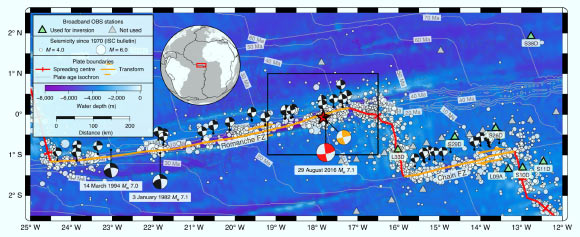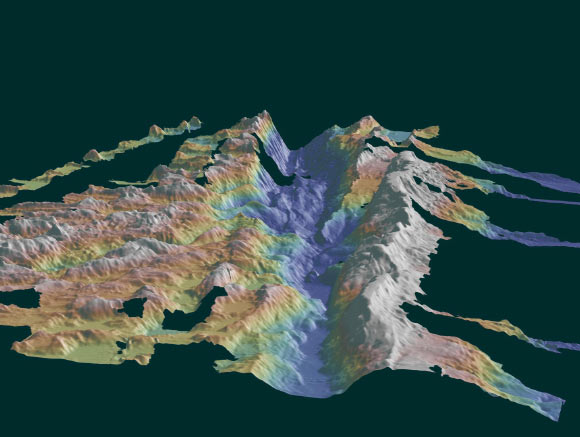Earthquakes occur when rocks suddenly break on a fault — a boundary between two blocks or plates. During large earthquakes, the breaking of rock can spread down the fault line. Now, geoscientists have recorded a ‘boomerang’ earthquake in the equatorial Atlantic, where the rupture initially spreads away from initial break but then turns and runs back the other way at higher speeds.

The 2016 7.1 earthquake on the Romanche Fracture Zone in the equatorial Atlantic. The map location is given by the red rectangle on the inset globe. Image credit: Hicks et al, doi: 10.1038/s41561-020-0619-9.
While large (magnitude 7 or higher) earthquakes occur on land and have been measured by nearby networks of seismometers, these earthquakes often trigger movement along complex networks of faults, like a series of dominoes.
This makes it difficult to track the underlying mechanisms of how this ‘seismic slip’ occurs.
Under the ocean, many types of fault have simple shapes, so provide the possibility get under the bonnet of the ‘earthquake engine.’ However, they are far from large networks of seismometers on land.
Dr. Stephen Hicks from Imperial College London and the University of Southampton made use of a new network of underwater seismometers to monitor the Romanche Fracture Zone, a fault line stretching 900 km (559 miles) under the Atlantic near the equator.
In 2016, the researchers recorded a magnitude 7.1 earthquake along the fracture zone and tracked the rupture along the fault.
This revealed that initially the rupture traveled in one direction before turning around midway through the earthquake and breaking the ‘seismic sound barrier,’ becoming an ultra-fast earthquake.
Only a handful of such earthquakes have been recorded globally.
The authors believe that the first phase of the rupture was crucial in causing the second, rapidly slipping phase.

Reconstructed image of the Romanche Fracture Zone. Image credit: Hicks et al, doi: 10.1038/s41561-020-0619-9.
“Whilst scientists have found that such a reversing rupture mechanism is possible from theoretical models, our new study provides some of the clearest evidence for this enigmatic mechanism occurring in a real fault,” Dr. Hicks said.
“Even though the fault structure seems simple, the way the earthquake grew was not, and this was completely opposite to how we expected the earthquake to look before we started to analyze the data.”
“However, if similar types of reversing or boomerang earthquakes can occur on land, a seismic rupture turning around mid-way through an earthquake could dramatically affect the amount of ground shaking caused,” the scientists said.
“Given the lack of observational evidence before now, this mechanism has been unaccounted for in earthquake scenario modeling and assessments of the hazards from such earthquakes.”
“The detailed tracking of the boomerang earthquake could allow us to find similar patterns in other earthquakes and to add new scenarios into their modeling and improve earthquake impact forecasts.”
The findings were published in the journal Nature Geoscience.
_____
S.P. Hicks et al. Back-propagating supershear rupture in the 2016 Mw 7.1 Romanche transform fault earthquake. Nat. Geosci, published online August 10, 2020; doi: 10.1038/s41561-020-0619-9







